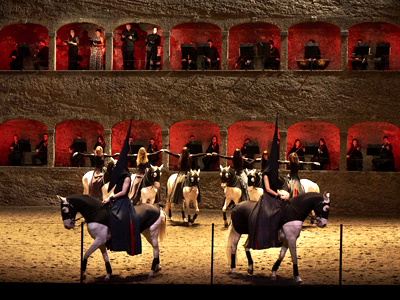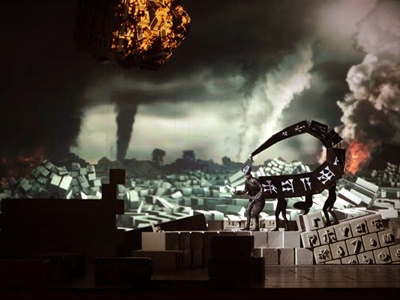
By ANDREW POWELL
Published: February 24, 2017
SALZBURG — The gimmicky proposition of Mozart’s Requiem enhanced with equine ballet dominated this year’s Mozartwoche schedule, and no doubt budget. It capped, in a way, five iterations of the festival lavishly managed by Marc Minkowski and his front-office counterpart Matthias Schulz, and it brought in for the second time the French conductor’s compatriot Clément Marty, called “Bartabas,” to choreograph the horses and riders of his Académie Équestre Nationale du Domaine de Versailles. Conventional fare for 2017 included the Vienna Philharmonic in three programs, concerts by five other orchestras, and much chamber music.
Minkowski kept the Mass tempos brisk Jan. 29, and textures fairly clear given the stashing of all voices and instruments in the Felsenreitschule’s arrayed stone arches. The vocal quartet (Genia Kühmeier, Elisabeth Kulman, Peter Sonn, Charles Dekeyser) and the Salzburger Bachchor sang with poised radiance; Les Musiciens du Louvre, unable to hear each other normally, appeared keenly attentive to Minkowski’s distant signals, but their instruments did not fully project.
Eight blue-eyed, cream-coated Lusitanos, new to Austria, trotted, walked or stepped in calm, tidy formations through most of the score. Brief sudden flurries punctuated this tame pageant when the composer seemed to prompt, for instance for the Confutatis, and Bartabas’ own “Soutine,” a black stallion, effected a silent spotlit solo roly-poly before the Sanctus, a kind of seventh-inning scratch likely meant for contemplation. But aside from occasional grunts, snorts and ear-flappings (often a tempo), the Académie’s efforts added little in drama or spirituality.
Minkowski instructively framed the main work, without ballet. Mozart’s pensive A-Minor Miserere for three voices (1770) established the choral sound unopposed, its alternating verses sung to plainchant. Then came the Symphony from Händel’s Funeral Anthem for Queen Caroline “The Ways of Zion Do Mourn” (1737), whose first chorus lends the theme for the Requiem’s Introito. Afterwards, the familiar Ave verum corpus refocused ears and eyes on Salzburg’s polished choristers.
In the Eroica Symphony the previous evening (Jan. 28), Thomas Hengelbrock’s understating of rhythmic accents created irresolute impressions. But the NDR conductor traced the second movement’s deathly promenade in gripping dynamic detail, courtesy of the Vienna Philharmonic strings, and to the Finale he brought weight, drama, and the broadest lyricism, riding confidently on Beethoven’s counterpoint.
The Großes Festspielhaus concert began with the overture to Don Giovanni, played vigorously and with considerable power. These qualities carried over to Mozart’s D-Minor Piano Concerto, K466 (1785), suiting Leif Ove Andsnes’ conception of the solo part: lucid, to a degree elegant, not especially charming. Beethoven’s cadenza in the first movement sounded splendid yet out of place; Andsnes opted for Hummel’s in the third movement, concise and less Romantic. There were occasional problems in the horns and trumpets.
Cappella Andrea Barca, regular guest of Mozartwoche, upheld its sterling reputation in a generous Mozarteum matinée Jan. 29, captained from memory by András Schiff. The Prague Symphony (1786) emerged in deep, neatly distinguished colors, product of a light string body resonating low on the hall’s cozy platform, with violins divided and a bass on either side. Beguiling flute, oboe and bassoon work did the composer proud; rhythms were pointed smartly. Haydn’s Clock Symphony (1794), after the break, traded elegance and humor as required. Cellos anchored the Cappella’s consistently handsome sound.
Schiff opened and closed the program playing concertos on a modern Bösendorfer: a witty account of Haydn’s D-Major Piano Concerto (1780), its contours inflated and flattered by the warm acoustics; and a gracefully phrased Piano Concerto in A Major, K488 (1786), indeterminate in mood, but with its illusive logic held together convincingly across all three movements. Bravissimo.
Photo © Matthias Baus ISM
Related posts:
Mozartwoche: January’s Peace
Nitrates In the Canapés
Salzburg Coda
Pintscher Conducts New Music
Tonhalle Lights Up the Beyond

Mozartwoche: January’s Peace
Monday, February 15th, 2016By ANDREW POWELL
Published: February 15, 2016
SALZBURG — There is a pleasure in arriving in Salzburg with snow on the ground. Or maybe the word is reassurance: the city will be real, not a theme park; the people mostly locals, despite the hollowing out of property ownership here; the profile quiet, even intimate, affording a chance to connect with the past. Of Salzburg’s festivals, the snowiest inevitably is Mozartwoche, planned and manned by the Mozarteum to straddle the composer’s birthday, often by more than a week. Last year’s edition achieved a coup by returning horses to the Felsenreitschule, for Davidde penitente as realized by “French equine artist and theatrical genius” Bartabas; next year, managers Marc Minkowski and Matthias Schulz let Bartabas loose on Mozart’s Requiem (Mel Brooks having declined) and promise some thirty concerts besides, including three by the Vienna Philharmonic, with Haydn as “focus composer.”
Mozartwoche 2016, placing Mendelssohn in focus, opened Jan. 22 with spoken words lauding the long contribution of Nikolaus Harnoncourt not only to Mozart’s music but specifically to this festival, where he was again due to conduct before declaring several weeks ago his instant retirement. The packed day teamed Katia et Marielle Labèque with the Mozarteum-Orchester in the morning, continued at 3 p.m. with an András Schiff recital, and ended soberly with Mozart masses at the Großes Festspielhaus led by John Eliot Gardiner. Rewards were many, irritations few.
The matinee sorely needed a conductor to temper dynamics and coordinate the shaping of lines. Where was Ivor Bolton? It began with a Mendelssohn Trumpet Overture (MWV P2, 1826) that knew no piano. Next came Mozart’s E-flat-Major Concerto for Two Pianos (1781) and chronically clunky phrasing by the French sisters; this was redeemed somewhat by a neatly sprung Rondo. Quality rose with a still loud, yet spry, Schauspieldirektor Overture (1786), the music’s inventiveness laid out vividly. The teenage exuberance of Mendelssohn’s Concerto in E Major for Two Pianos (MWV O5, 1823), in conclusion, proved a good match for the Labèques; alas they then imposed a duo encore (and an insipid one, the last of Glass’s Four Movements for Two Pianos, 2008) to ruin our exit.
The Mozarteum’s Conrad-Graf-Flügel and Walter-Hammerflügel (1839 and 1782) stood side by side on the platform for Schiff’s recital. Mendelssohn came first: the Variations sérieuses (1841) and the F-sharp-Minor Sonate écossaise (1833), played on the later instrument with its charming pearly highs and fuzzy, attenuated lows. Schiff made inspired sense of the lines in both works and bound Mendelssohn’s ideas together expertly without shying from a breakneck pace where needed. The Walter’s clarity and evenness through the range made a stark contrast, its modest sound easy to settle into in this artist’s hands. Ideal tempos and immaculate voicing sustained Mozart’s late major-key sonatas, in C (für Anfänger), B-flat and D; the poise of Schiff’s playing overcame passing glitches.
Gardiner’s highly musical, not especially spiritual, reading of the Große Messe K427 (1783) closely resembled the adjusted Aloys Schmitt reconstruction he recorded in London decades ago. His crisp rhythms and airy textures, and the way these flattered the score’s abundant lyricism, seemed designed to please, as if Mozart had composed the truncated service just for today’s Monteverdi Choir and English Baroque Soloists. From this listener’s seat, vocal soloists Amanda Forsythe, Hannah Morrison (sopranos), Gareth Treseder (tenor) and Alex Ashworth (bass) could not be seen or properly heard, but the choir, also mostly out of view, sounded disciplined. Orchestrally it was a performance with resilience, wary balances, individual style; veteran sackbuttist Stephen Saunders managed to nod off during Forsythe’s Et incarnatus est, nearly losing his instrument off the riser’s edge. A horseless Mozart Requiem followed the break; for practical reasons we could not stay.
Photo © Tourismus Salzburg
Related posts:
Salzburg Coda
Horses for Mozartwoche
Mariotti North of the Alps
A Stirring Evening (and Music)
Maestro, 62, Outruns Players
Tags:András Schiff, Bartabas, Commentary, English Baroque Soloists, Felsenreitschule, Großes Festspielhaus, John Eliot Gardiner, Katia et Marielle Labèque, Mendelssohn, Monteverdi Choir, Mozarteum, Mozarteumorchester, Mozartwoche, Nikolaus Harnoncourt, Piano, Review, Salzburg, Sonate écossaise, Variations sérieuses, Wolfgang Amadeus Mozart
Posted in Munich Times | Comments Closed